Jammu lies in the low-lying Tawi River basin at the edge of the northern plains. Tracing the city’s beginnings into pre-history, oral traditions say that Raja Jambu Lochan founded the city in the Vedic period, around the 14th century BCE. Once while out hunting, he saw a tiger and a goat drinking from the same watering hole. Amazed at this demonstration of peaceful coexistence, he founded a city here, calling it Jambupora, which evolved into Jammu. Modern-day Jammu is the winter capital of Jammu and Kashmir state. It styles itself as a ‘city of temples’ and lists no less than 46 shrines of the Hindu, Sikh, Muslim, Christian and Jain faiths within its limits.
THINGS TO SEE AND DO
Amar Mahal Museum and Library and Hari Niwas Hotel
When approaching Jammu from Nagrota in the north, the first structure you see is the red brick Amar Mahal Museum and Library, perched high on a ridge surrounded by trees, overlooking the Tawi River’s northwestern bank. Rhesus monkeys play catch on top of a signboard that points to this 19th-century palace that was the last official residence of the Dogra kings. Designed by a French architect for Raja Amar Singh, it now houses a museum run by the Hari-Tara Charitable Trust, and has a fine collection of miniature paintings from the Kangra school featuring the archetypal lovers, Nala and Damayanti and works of several famous artists.
Located within the same 50-acre complex is another crisp white palace, fronted by cannons and the Dogra crest – the Hari Niwas Palace. Built by Raja Hari Singh and converted into a hotel in 1990, it is one of Jammu’s best heri-tage properties.

Bahu Fort and Bagh-e-Bahu
Set on a hill overlooking the Tawi River, Bahu Fort fort is believed to be Jammu’s oldest extant structure, as it is said to have been built by the Vedic-era king, Bahu Lochan, over two millennia ago. Maharaja Gulab Singh refurbished its low-slung ramparts in the 1820s and also built the Mansabdar’s Palace within. In front of the fort are the lovely terraced gardens of Bagh-e-Bahu, full of seasonal flowers and fountains. Early mornings and evenings are the best times to visit, if only for the views across the Tawi River and the twinkling lights of the Old City beyond. The Mubarak Mandi Palace is clearly visible on the opposite bank.
Other places of interest in Jammu include the Manda Deer Park opposite the Amar Mahal Museum, Shri Raghunath Mandir in Old Heritage City, Peer Kho on the banks of River Tawi and the Ranbireshwar Temple in the old city.
WHERE TO STAY AND EAT
ITDC’s Hotel Jammu Ashok (Tel: 0191- 2543571-76; Tariff: ₹2,700–6,500) is opposite Hari Niwas Palace. JKTDC’s Hotel Jammu Residency (Tel: 2579554; Tariff: ₹1,100–5,500) is a good option. Bazaars around Raghunath Mandir are full of dhabas. Do try the famous Amar Vaishno Dhaba, and Khana Khazana, famed for its Dogri thali. Go to Wazwan in Jammu Residency for local cuisine.
THE INFORMATION
When to go November–March
Tourist Office
J&K Tourism, Tourist Reception Centre, Residency Road, Jammu, Tel: 0191-2548172, W jktourism.org, STD code 0191
GETTING THERE
Air Satwari Airport. Taxi (Cell: 09779 94211) charges ₹500 to the city centre
Rail Jammu Tawi
Road Jammu is on the good, all-weather NH1A going to Srinagar (north) and Jalandhar (south). Call the Tourist Reception Centre, JKSRTC (Tel: 0191- 2576562) for bookings and enquiries




